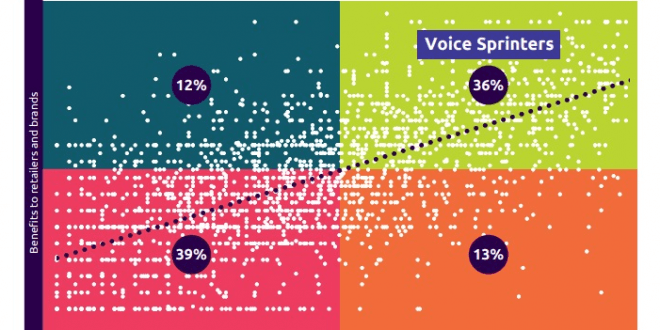 A new global survey of 5,000 consumers by Capgemini shows that conversational commerce is finding its voice with online shoppers.
A new global survey of 5,000 consumers by Capgemini shows that conversational commerce is finding its voice with online shoppers.
The research highlights the opportunities ahead for retailers who provide voice shopping as a way to engage in a growing new e-commerce channel with consumers.
Where is voice commerce now?
51% of consumers surveyed said they already use voice assistants with 81% of those engaging via their smartphone and a surprising 25% are already using voice via smart speakers. Another 21% used it with a non-phone screen device such as Amazon Fire TV.
Overall, 71% of consumers are happy with their voice assistant experience and more than 80% overall are satisfied with voice assistants used for purchasing.
Where are consumers using voice assistants?
According to Capgemini, consumers are already using voice for a wide range of tasks and services including shopping:
 82% – Seeking information, like news, weather, recipes
82% – Seeking information, like news, weather, recipes- 67% – Playing music or streaming videos
- 36% – Accessing customer service
- 35% – Buying products, such as groceries or clothes
- 34% – Ordering a meal
- 28% – Making a payment or sending money
- 28% – Booking an Uber or taxi service
- 31% – Controlling smart home devices.
Where is conversational commerce interest highest?
Consumers are most interested in ordering meals (56%), buying services such as booking a taxi (54%), buying electronics (52%), buying products such as books and supplies (49%), buying clothes (46%), groceries (45%) and personal care (44%).
The report highlighted retailers already providing voice shopping including Walmart’s 2 million products available using Google Voice; French cosmetics retailer Sephora; and UK supermarket Ocado.
Consumer preferences for voice assistants
The Capgemini report highlighted some interesting conversational commerce dynamics:
- 82% of users said fast, accurate replies are the most important feature followed by understanding diction and accent (81%) and relevance of recommendations (75%)
- more than 69% prefer using voice assistants in their living room with 61% in the kitchen
- only 32% were comfortable using voice assistants around unfamiliar people
- safety and security of personal data is critical (71%)
- liked saving money through deals and promotions (68%)
- saving time in purchasing (64%)
- nearly 20% have annual household income of more than $100K and the majority of users are between 33 and 45 years.
Barriers to voice assistant adoption?
There were several key barriers and concerns with voice assistants according to the research.
- 65% of consumers didn’t trust security of their data
- 61% saw no need for voice assistants
- 59% said there was no incentive to use it
- 59% thought it was intrusive and asked for too much personal information
- 57% were uncomfortable speaking to a machine
- 54% said it did not help them visualize information or products
- 48% said voice assistants did not understand them or their directions.
Voice assistant non-user barriers
 Non-users of voice assistant services had a list of interesting reasons for not liking the idea of a machine making purchases for them.
Non-users of voice assistant services had a list of interesting reasons for not liking the idea of a machine making purchases for them.
37% did not trust Google/Siri/Amazon to make a decision in their best interest. 23% were concerned to someone might impersonate or order for them. 19% wanted to set up their first-order and then use voice assistants for future orders and 17% wanted to know how order decisions were made. Finally, 16% wanted to try it a few times before allowing voice assistants to order for them.
Where is conversational commerce going in the future?
While 24% of consumers say they would rather use a voice assistant than a website, within three years, research shows 40% will prefer using voice for shopping.
When it comes to banking, three years from now, 31% will prefer voice banking over visiting a shop or bank branch.
 Conversational commerce spending using voice assistants will grow from 3% to 18% within three years among current users. 7% of non-users expect to be spending using voice assistants.
Conversational commerce spending using voice assistants will grow from 3% to 18% within three years among current users. 7% of non-users expect to be spending using voice assistants.
Finally, and most importantly, 16% of consumers expect they would increase their spending on consumer products via a brand providing a better voice assistant experience.
Free voice assistant shopping report available
All in all, it’s a fascinating research study with valuable insight for both traditional and online retailers.
5,000 consumers in the US, the UK, France and Germany were surveyed, and you can view a free copy of the report and research results here.


